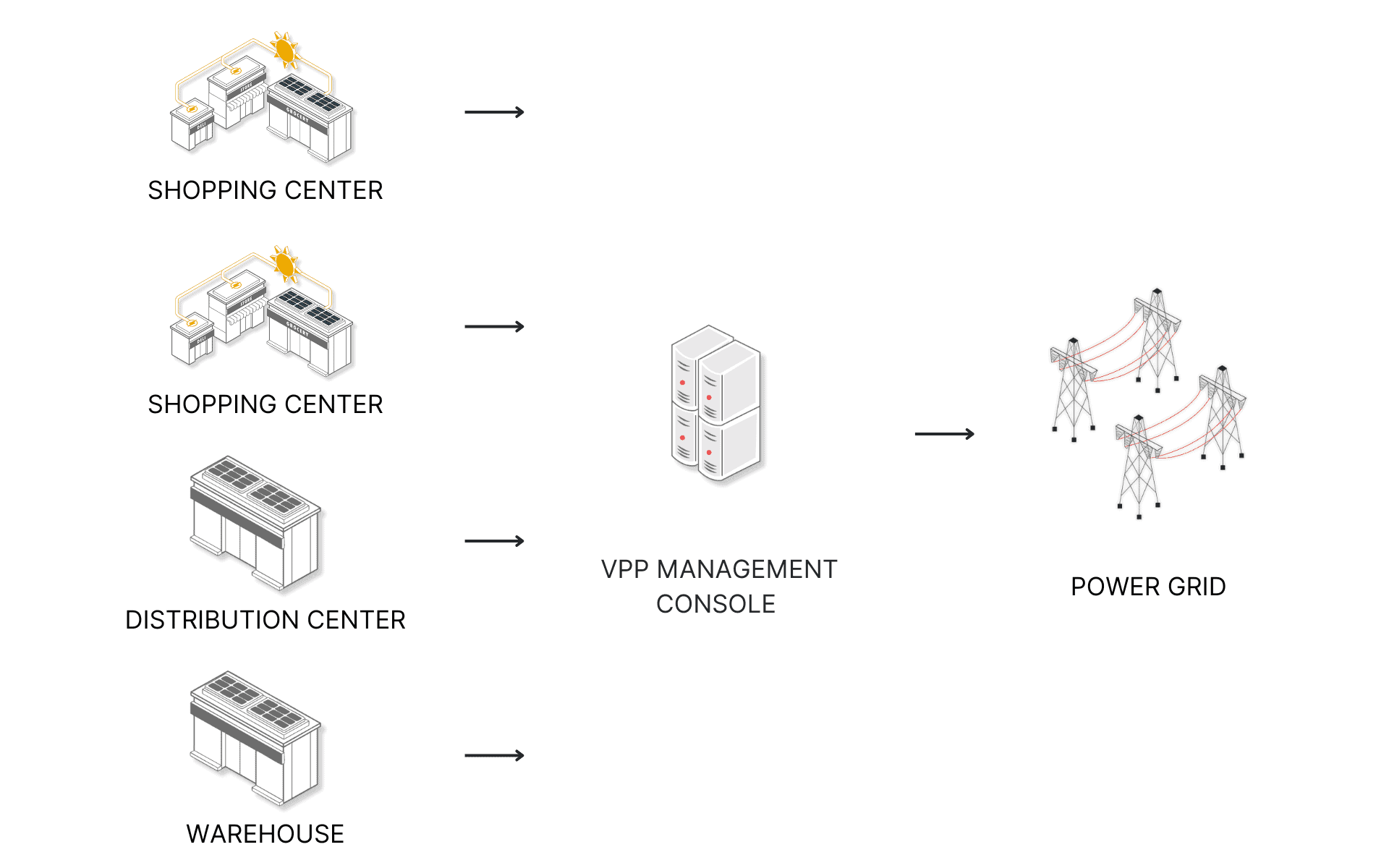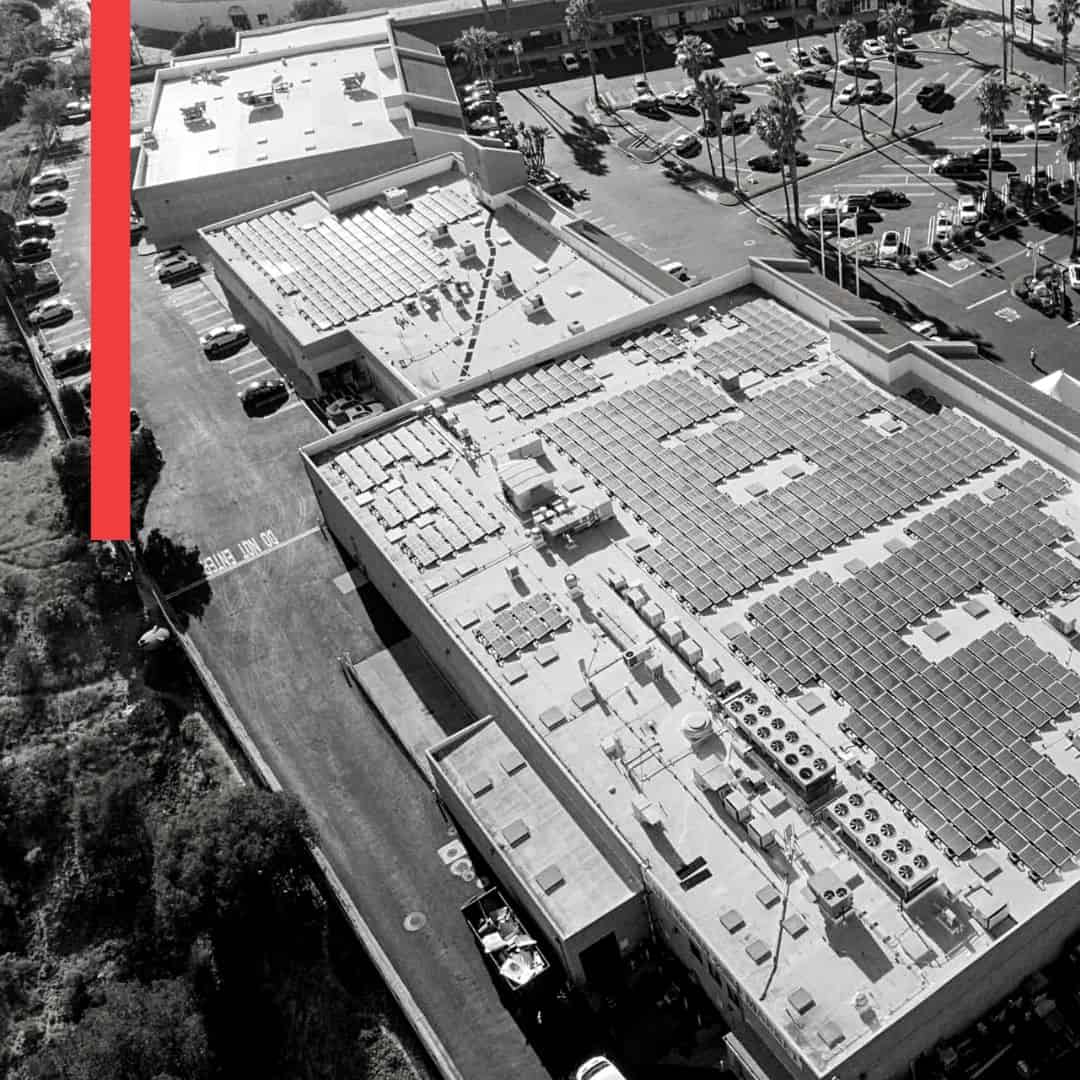For real estate investment trusts and local property owners alike, energy independence and efficiency are becoming key objectives to realize success. Rising costs of grid electricity and other economic factors make having comprehensive strategies a must. Due to the increasing availability of technologies, many commercial and industrial (C&I) property owners are managing their electricity needs with renewable energy. Many have already discovered that solar power offers more than just environmental benefits—there are significant financial advantages as well. But what if there was a way to take this energy approach a step further? Enter the world of virtual power plants (VPPs), a new renewable asset model that will be reshaping how C&I properties interact with the grid while opening up new avenues for energy optimization and revenue generation.
What is a Virtual Power Plant?
A virtual power plant is a network of solar and storage systems, and flexible power consumers. Unlike traditional power plants, VPPs don’t have a central physical location. Instead, they bring together multiple clean energy projects, coordinating between them to provide power back to the grid when needed. VPPs work by integrating various distributed energy resources notably solar panels and battery storage systems. These resources are orchestrated through sophisticated software that allows them to act as a single system, responding to grid demands in real-time. It’s important to note that while VPPs share some similarities with microgrids, they’re not the same thing. Microgrids are localized power systems that can operate independently from the main grid, while VPPs remain connected to and work in tandem with the broader power infrastructure providing local power on-site and offering power during peak demand directly to the utility itself
How Do Virtual Power Plants Work for Commercial Properties?
At the commercial scale, virtual power plants work by bringing together isolated high-producing energy systems and coordinating their energy distribution to create maximum impact. A VPP site on commercial properties is formed when multiple sites with solar and battery installations are coordinated to feed power to the grid as a single unit. This structure allows for more efficient energy distribution and can provide substantial benefits to both the property owners and the broader grid infrastructure. On the surface, they function like any typical local solar energy program. The commercial property has solar panels installed on the property that generate clean electricity. Most of that energy is used on-site, and unused power is transferred to the grid. To increase resilience and allow for better allocation, VPPs typically rely on energy storage. These solar battery systems store excess energy on-site for later use, often when the grid experiences high demand. In order to allow these independent energy systems to coordinate together, VPPs need intelligent software that can orchestrate the process. This advanced software monitors energy production, storage levels, and grid demands. Finally, this software communicates with the power grid. The system communicates with the power grid, automatically providing energy from the storage of the VPP when it’s most needed.
Do VPPs Exist at Commercial Properties?
As we progress towards 2030, it is expected that commercial properties will be an important part of the overall virtual power plant strategy. By working together, their generation potential can radically improve grid stability, reduce energy costs, and improve the public’s access to renewable power. Commercial and industrial properties are ideal candidates for VPP participation due to their large, often underutilized, roof spaces. These expansive areas are perfect for installing substantial solar arrays capable of generating significant amounts of energy supply. But while solar installations are becoming increasingly common at C&I properties, battery storage, and software integration needs to gain more traction in the commercial space. This infrastructure, combined with leaders that can unify networks, can create a coordinated system of solar and battery installations that works at scale. We see the 2025 to 2027 timeframe as the period where viable VPP software solutions paired with battery storage make the first C&I VPPs become a reality. Several states are leading the charge in VPP adoption at commercial sites, offering incentives and benefits to participating properties. California, Massachusetts, New York, and Texas are at the forefront, with other incentive programs springing up across the nation showing promising results.
What is the Future for Virtual Power Plants?
The future of virtual power plants looks bright, especially with the growing involvement of C&I properties. As solar and battery storage installations continue to grow at commercial sites, more megawatts will become available to support the grid and benefit communities. Software solutions are already in development to coordinate VPP infrastructure across C&I properties. These advancements are crucial because they will allow for more efficient energy distribution and management on a large scale. Growth trends indicate that VPPs could represent a significant portion of peak electricity demand in the coming years. North America, particularly the U.S., is expected to see significant growth, with the U.S. VPP market projected to reach $1.17 billion by 2032. Once they reach critical mass, VPP tech will likely evolve to achieve greater standardization. First starting as commonly owned portfolios of C&I solar and battery installations, they’ll expand further as industry-standard software solutions emerge. Finally, utilities will provide standard integration processes for grid communication.  And who will be the biggest winners in this growth? The end user and the solar program owner. Energy users will experience lower energy bills and greater resilience, while the early adopting solar owner reaps the rewards of incentives and expanded use.
And who will be the biggest winners in this growth? The end user and the solar program owner. Energy users will experience lower energy bills and greater resilience, while the early adopting solar owner reaps the rewards of incentives and expanded use.
How Can I Join a Virtual Power Plant?
To become a part of a virtual power plant, commercial properties need to join an existing power generation network or be a piece of a larger real estate portfolio with renewable energy assets. They will need a solar system, energy storage, and the ability to run VPP software to coordinate distribution. For many commercial properties, the easiest way to integrate into a virtual power plant is to work with an experienced solar partner. These partners play a crucial role in managing the technical aspects of participation, coordinating with utilities and energy markets, and optimizing energy production and storage to maximize benefits. An experienced solar partner, King Energy is an innovator in energy billing and VPP management software and is also one of the leading providers of solar and battery solutions to C&I properties in North America. Their solar installations are managed through the King Energy OneBill software platform, which provides a framework for integrating with utilities and managing VPP programs. Commercial property owners looking to get started with solar without the complexities of system ownership can easily access its financial benefits through a solar lease. King Energy installs a solar array on commercial roofs at no cost, paying monthly rent for the space. They offer discounted energy to tenants, and owners see increased property value and NOI. This arrangement enables owners to benefit from solar power and potentially participate in future VPP programs without any upfront investment or complicated relationships. Whether they are looking to optimize energy usage, meet ESG goals, or explore new revenue streams, solar could future-proof properties by placing them on solid footing to adapt to evolving trends. With solar adoption in the mainstream and virtual power plants on the horizon, there’s never been a better time to unlock the financial benefits. Learn more about how your commercial property can grow with solar Contact King Energy for a personalized proposal.

